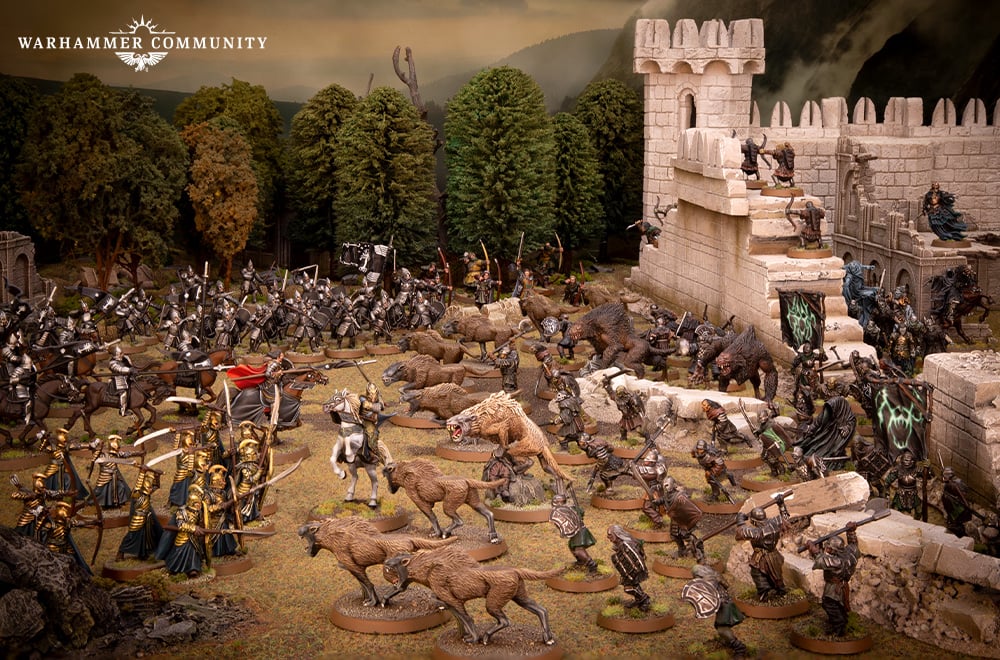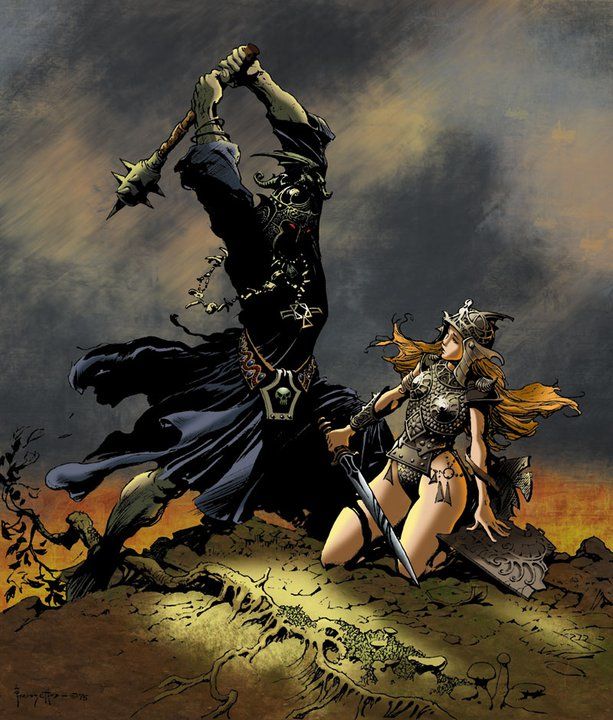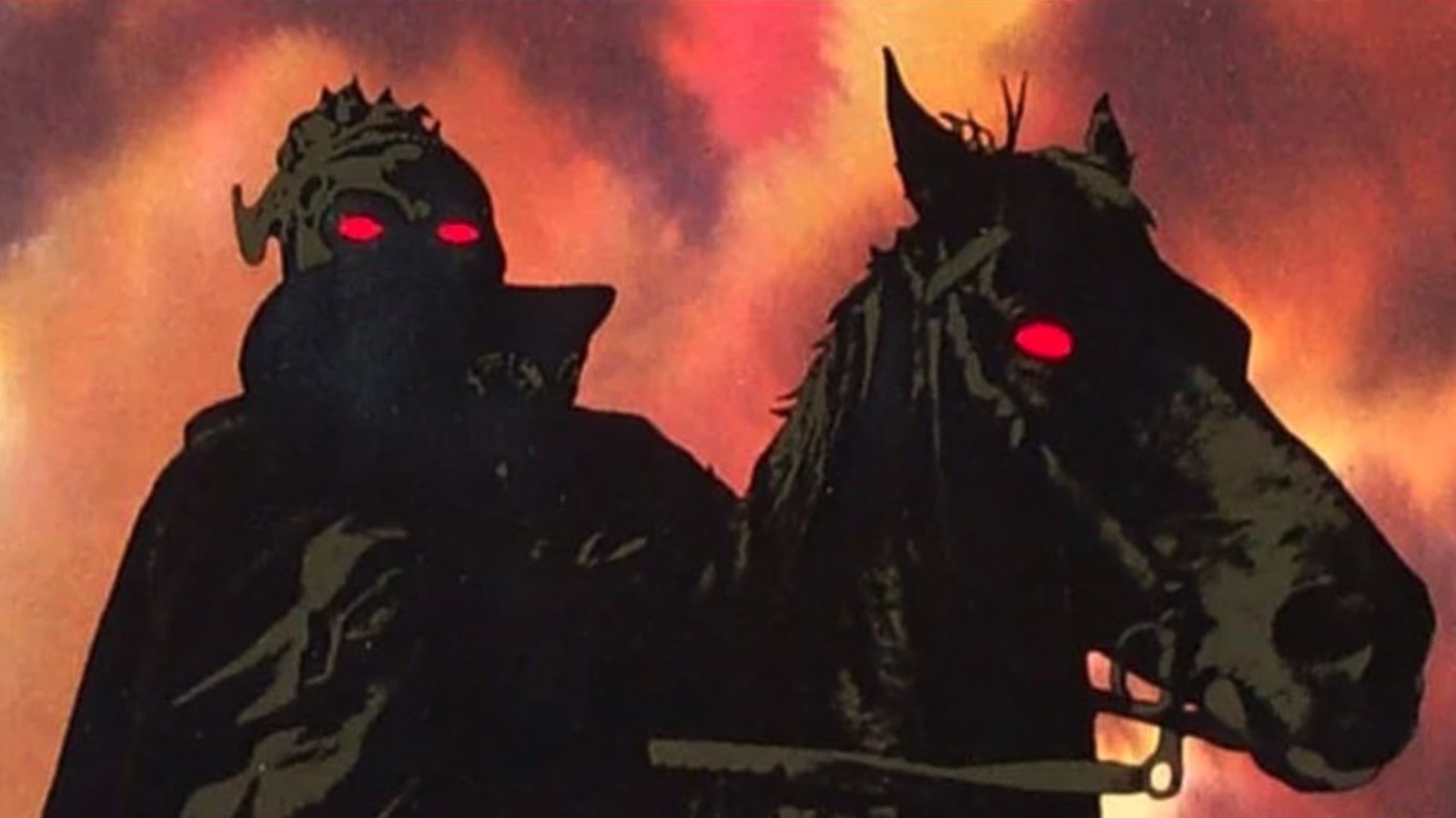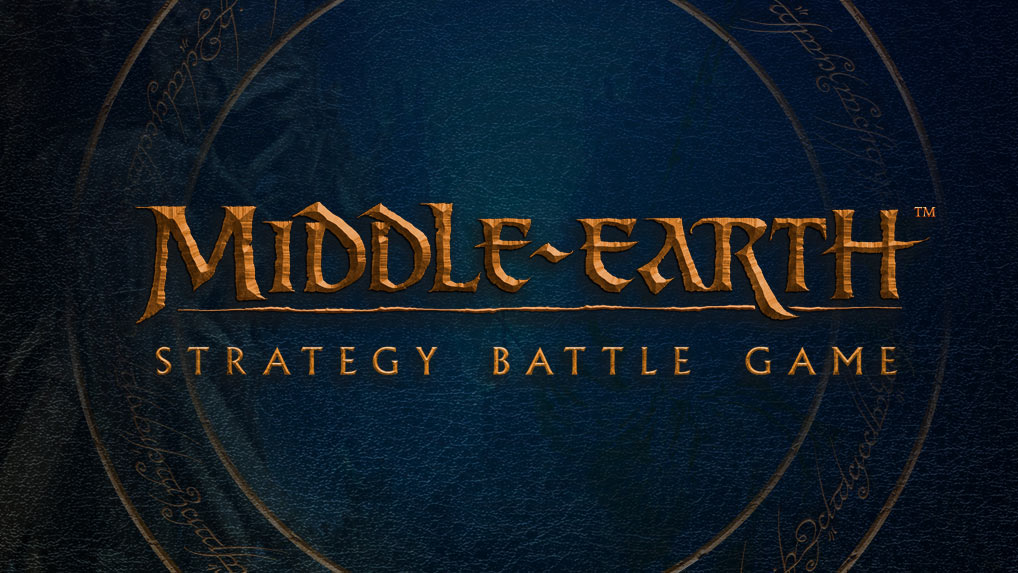With Rise of Angmar hitting stores and gaming tables soon, Thundercloud takes a dive into the lore, scenarios and campaign in the book.
We would like to thank GW for providing a copy of Rise of Angmar for review.
The Lore
While the lore in the book starts with the founding of Arnor and Gondor and then the Last Alliance of Men and Elves defeating Sauron, it’s worth discussing a little of what came before and some detail the book doesn’t go into in the four pages it gives for the overview.
During the first Age, after the victory over Morgoth, the Valar reward the Men that fought alongside them and the Elves against Morgoth with the island kingdom of Numenor, which they raise from below the sea. However the victory over Morgoth isn’t complete, and Sauron, plenty of Orcs and a bunch of other gribblies survive and hide away waiting for the heat to cool down. Sauron is immortal, so he just hides away and does hobbies or something waiting for the cops/elves/Valar to get bored. Like in GTA.
Sauron comes back disguised as Annatar, the Lord of Gifts, and helps Celebrimbor and the Elves create the Rings of Power, to slow the decay of the world and make it more like Valinor. Sauron works with Celebrimbor creating 16 rings, Celembrimbor creates three more Elven rings on his own, and Sauron forges the One ring at Mount Doom, to rule them all. As soon as Sauron puts the One Ring on the elves catch on that there’s something screwy about this rings thing, and take their rings off. Sauron then takes 15 of the 16 other rings by force (Celebrimbor gives one to the Dwarves of Khazad Dum) and gives another five to the Dwarves and nine to kings of men, who become the Ringwraiths. The Dwarves aren’t corrupted as much, but get very greedy and the rings become the foundation of great hoards of gold and jewels that do things like attract dragons. This leads to the destruction of four of the rings in dragon fire, and Sauron recovers the other three at some point.
So Sauron is warring with the Elves in Linden, and the Numenorians come to their aid, driving Sauron out of Eriador and about a century later starting to settle around the coast of Umbar. The Ban of the Valar prevented the Numenorians from sailing west to the Undying Lands, but they colonised (at first in a friendly way and then more tyrannically) the coast of Middle-Earth, founding a maritime empire and oppressing the men living under their control. This comes back to bite them later.

Sauron began raiding the Numenorean settlements, and the Numenoreans rock up with a massive gang of the lads and Sauron wusses out and surrenders, and is taken back to Numenor as a prisoner. This doesn’t stick though, and soon he’s advising the Numenorean King, Ar-Pharazôn, that the Valar haven’t done much for him lately and maybe he could give worshipping Morgoth a try. It’s a slippery slope from there to human sacrifices, declaring war on the Valar and invading the Undying Lands. The Valar respond by changing the world to a sphere rather than flat and drown Numenor beneath a big wave after warning the Numenoreans who were loyal to the alliance with the Valar and Elves to get out of dodge. These Numenoreans found Arnor and Gondor with the help of the Numenorean colonists that had been doing all the oppressing along the coast of Middle Earth, though those around Umbar sided with Sauron and became the Black Numenoreans.
As the Royal line of Numenor are descended from Elrond Half-Elven’s brother Elros, they live 2-300 years, which explains the longevity of the Dunedain.
The lore in the book basically picks up from there. Arnor, ruled by High King Elendil and Gondor, ruled by his son Anarion, join the last Alliance, and Elendil and Anarion are killed by Sauron, who in turn has the One Ring cut from his finger by Isildur. Isildur is killed by Orcs two years later, and the line of Isildur rules Arnor and the line of Anarion rules Gondor, splitting the kingdoms into two distinct political entities.
Eight hundred years later High King Eärendur of Arnor dies, splitting into three smaller kingdoms Arthedain, Cardolan and Rhudaur, with Arthedain ruled over by Amlaith, who as the eldest son had the right to the throne of Arnor.
This leads to bickering and decline, and the three kingdoms fight each other over the watch tower of Amon Sul and the Palantir therein.
A little over 400 years later, Sauron sends the Witch King to the north, who founds the Kingdom of Angmar to do some witchin’ and kingin’ in. This marked the end of peace in the North, and the start of a constant state of warfare, raiding and endless grinding that wore down the three kingdoms. The hill men of Rhudaur swore allegiance to the Witch King, sick of the House of Isildur and it’s descendants, and the first domino falls and joins Angmar. Bolstered by this, the Witch King assaults the newly constructed fortifications along his new border with Arthedain, and King Argeleb of Arthedain was slain before the combined forces of Arthedain, Cardolan and the Elves of Linden were able to drive the Witch King back.
The Witch King gives Arnor a bit of a breather, turning his attention to Rivendell on his east flank, besieging Imladris for over 50 years before reinforcements arrive from Lothlorien in 1409 and lift the siege.
The Witch King then turns his attention to Cardolan almost immediately. Cardolan falls and it’s royal line is extinguished. While the Witch King is unable to claim the Palantir, King Arveleg of Arthedain is killed, Amon Sul is reduced to ruins and Arthedain then has another flank to defend. Again Cirdan and the Elves of Linden come to the aid of Arnor, helping push the Witch King out of Arthedain again. Elrond and his forces and a contingent of Galadrim join the fight and give the Witch King’s forces such a beating that it takes them centuries to recover.

With much of Arnor depopulated, King Argeleb II allows the Hobbits to settle in Arnor, and the Shire is founded in 1601. The Hobbits fall under the rule of Arnor and they contribute archers to the army of Arnor.
The scattered survivors of Cardolan are wiped out by a combination of the Great Plague of 1636 and spirits raised from the dead in Tyrn Gorthad, which becomes the Barrow Downs.
Gondor at this time is busy with the Kin Strife, a bitter civil war that saw much of the aristocracy of Gondor killed and the formation of the Corsairs of Umbar who would plague Gondor for centuries after, and then the Great Plague. Following the invasion of Gondor by the Wainriders in 1851, and a series of wars against them and the men of Harad.
In 1944 Gondor faced a succession crisis when King Ondoher was killed in battle along with his sons and Prince Arvedui of Arthedain put forward a plan to reunite Gondor and Arnor, but this was rejected and Earnil II, a distant relative of Ondoher, was placed on the throne.
Arvedui, now king of Arthedain, sent for help from Gondor in 1973, but it doesn’t turn up in time. The Witch King captures Fornost in 1974, the last city in Arthedain, and Arvedui flees to the Icebay of Forochel where he is taken in by the men there. Cirdan and the Linden Elves send a ship to get him, and he gets on it despite the men of Forochel telling him it’s a bad idea and they don’t like the look of the weather.
Arvedui and the two Palantiri he has are lost beneath to waves and ice, ending the kingdom of Arnor.
Earnur and Gondor turn up a year later, in 1975, along with Elves from Rivendell under Glorfindel and some Hobbits, and the Witch King is defeated at the battle of Fornost. The Witch King’s retreat is blocked by Earnur, but he uses magic to cause Earnur’s horse to flee and Earnur is massively embarrassed. Glorfindel stops Earnur pursuing the Witch King, saying no man can slay him, and this proves correct when at the Battle of Pelennor Fields the Rohan warrior Dernhelm reveals that he is not, in fact, a twink, but a woman.

This pretty much ended the organised fighting in Arnor, with the Witch King achieving all his goals. He was then transferred to fight Gondor, capturing Minas Ithil in 2002 and renaming it Minas Morgul. Earnur wanted to go and challenge the Nazgul, but was talked out of it by his father’s steward. After Earnur became king in 2043 the Witch King challenged him and he was again talked out of it, but seven years later the Witch King challenged him again and Earnur left with a company of knights and was never seen again, bringing an end to the line of Anarion.
In the wilds of the Northern lands, the Dunedain and descendants of Isildur wandered around, skirmishing with trolls, orcs and goblins, but were too few in number to re-establish the kingdom of Arnor. After the death of Arathorn, Aragorn was raised in Rivendell in the house of Elrond and we know how that turned out.
Games Workshop put a lot more emphasis on the actions of Men in their summary of the lore, and skip over the actions of the Elves, particularly the Elves of Linden. However this is not represented in the scenarios, and the relief of Imraldis and the defence of Fornost by the elves is included in the scenarios.
Scenarios and Campaign
The book provides you with two sets of scenarios: One is the Rise of Angmar, with a set of win/loss bonuses if the scenarios are played as a campaign, and the other is the Appendix scenarios, which are about the Dunedain fighting Bruhdur the Hill Troll and other monsters hanging out in the wilderness. Both can be played individually, and given the miniature requirements for some scenarios (there’s a lot of expensive resin Carn Dum warriors in some) picking and choosing could be advisable.
The scenarios are asymmetric, and some are very much in the favour of one side of the other, but are well written, reflect the history in more detail than the history section, and provide a range of game experiences in terms of size and time that give players treats for a range of tastes.
None of the scenarios are particularly suited for matched play, but the Appendix scenarios could be played through by two experienced players in a day given their generally smaller size.

Haunted Ruins Masterclass
The narrative books generally include a modelling section, and this one focuses on making cool looking Haunted Ruins out of the Ruins of Middle Earth kit (though thematically the Gondor Ruins would work just as well).
While the section is good, and harks back to the De Agostini scenery articles, I think it could have been a little better. It’s obvious looking at the pictures that there are rock pieces made from sprue and some blue foam cut to shape to be fallen stones and internal features of the ruined building. Showing this and how they were made would have taken about a page and would help out less experienced modellers in recreating what is a very nice scenery piece.
The painting guide is well done and the effect is explained well (layers of drybrush basically) though I’m convinced Baneblade Brown isn’t as light as it appears in the pictures.
Conclusion
In normal circumstances I’d 100% recommend getting this. With the new edition imminent (I would expect it in October or November, given the new movie is out in December) I think it is something of a victim of timing. If this had come out well before the new edition announcement, I think the community would be overwhelmingly positive about it, as it adds five more solid legendary legions for the one day event crowd, and gives a lot of scenarios for narrative players. The miniatures in the release range from nice to incredibly nice, and the little gripes I have are just that, little gripes.
In our current timeline though I think the new edition, and the invalidating of the model rules even though GW have said they’ll put the new rules online for free when the new edition comes out, will impact sales and reception. Which is a shame, as this is a really good supplement.
Have any questions or feedback? Drop us a note in the comments below or email us at contact@goonhammer.com. Want articles like this linked in your inbox every Monday morning? Sign up for our newsletter. And don’t forget that you can support us on Patreon for backer rewards like early video content, Administratum access, an ad-free experience on our website and more.


